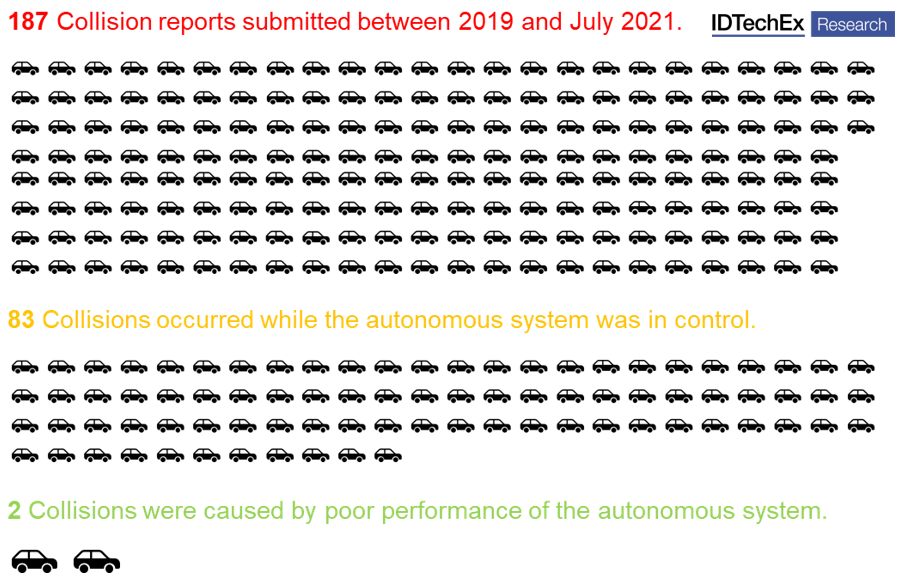
A new analysis of California’s autonomous collision reports suggests driverless vehicles may prove far safer than human drivers.
Every company testing autonomous vehicles in California must report any collision to the state’s department of motor vehicles (DMV). Emerging technology analyst firm IDTechEx in Cambridge, England, analyzed this data, spanning the past two and a half years’ worth of reports.
“It is not looking good for human drivers,” IDTechEx technology analyst James Jeffs said in a statement on Oct. 19.
Jeffs noted that from 187 reports, only two incidents could be attributed to the poor performance of the autonomous system. “That means a staggering 99% of crashes involving autonomous vehicles are caused by human error,” he said. “It is also worth mentioning that while the vehicles were operating in autonomous mode, 81 out of the 83 recorded incidents were caused by a human, either in another vehicle or as a misbehaving pedestrian.”
Upon delving into individual cases involving autonomous cars, “the ineptitude of some drivers becomes glaringly obvious,” Jeffs noted in the statement.
For example, in one case involving a Pony.ai car on July 12, 2019, at a traffic light-controlled junction, the autonomous test driver noticed the car in front had its reverse lights on. As a precaution, the test driver backed up 20 to 30 feet. When the lights turned green, the car in front accelerated in reverse, managing to stop short of the Pony.ai vehicle by four feet. Without changing out of reverse, the driver in front accelerated again and hit the Pony.ai vehicle.
In another instance on March 27, 2021, a Cruise vehicle was autonomously making a left turn at a four-way junction when a vehicle behind it attempted to overtake and carry straight on. The vehicle collided with the front left of the autonomous car. Similarly, on February 25, 2021, a Cruise vehicle was autonomously making a right turn at a junction and had right of way. A vehicle approaching from the left failed to stop for a stop sign and collided with the autonomous car.
In one last example Jeffs highlighted, on November 22, 2019, a human test driver was driving an autonomous Zooxvehicle in manual mode. “The test driver entered a junction under a green light and was hit by another vehicle illegally entering the junction while fleeing from the local police force,” Jeffs noted.
“The cases mentioned here are some of the more unusual and have been shared to demonstrate how poor human driving can sometimes be,” Jeffs said in a statement. “In the vast majority of the 81 cases where a human driver collided with an autonomously driven vehicle, the circumstances were far less interesting. The most common form of collision was simply being rear-ended while in traffic or stopped. These kinds of crashes are likely caused by either human inattention or distraction.”
“The point remains though that in the cases given and most other cases, it is highly unlikely that a collision would have occurred if both vehicles were autonomous,” Jeffs noted. “Autonomous drivers don’t mistake forward and reverse gears, they don’t take unnecessary risks such as overtakes and running stop signs, they always pay 100% attention, and finally, they won’t flee from the police.”
All in all, “around 95% of road traffic accidents are caused by human drivers,” Jeffs noted. “We are fallible, distracted, and potentially dangerous. Our liability behind the wheel is not just the problem of other human drivers, but can also be difficult for autonomous vehicles to contend with.”
In the two cases where the autonomous vehicles were at fault, both cases involved a Zoox vehicle, and in both cases, the Zoox autonomous system appeared to misjudge its clearance to parked vehicles it was attempting to navigate around. The Zoox vehicles made contact, causing some minor damage.
“It is likely that this was either a weakness or blind spot in the sensor suite, or a fault of the autonomous driver,” Jeffs noted. “Either way, as R&D activities are still underway, autonomous vehicles are not yet 100% infallible, and likely never will be.”
Still, autonomous and connected vehicles have many advantages over human drivers,” Jeffs noted. “They have permanent 360-degree perception, they can communicate their intentions to each other in advance, and they do not make silly operational errors, such as accidentally engaging reverse. As their maturity progresses, it will be hard to deny that they are superior to human drivers, and we will need to take a back seat in the task of driving.”

